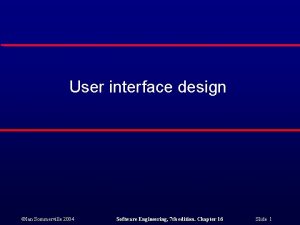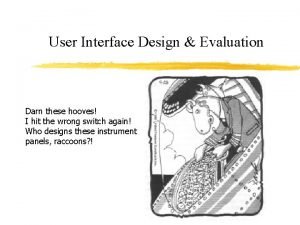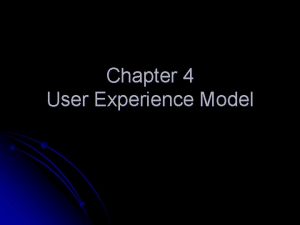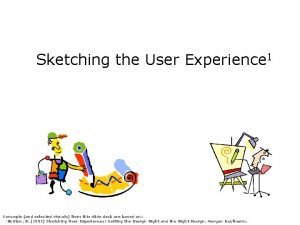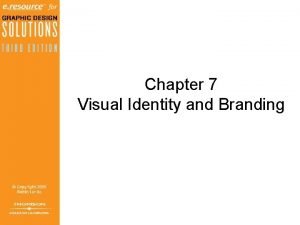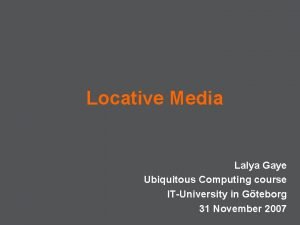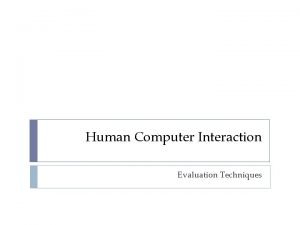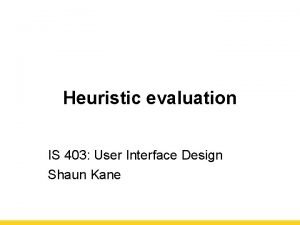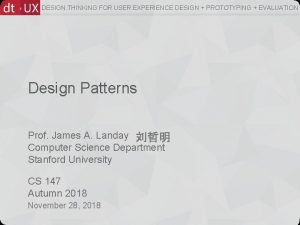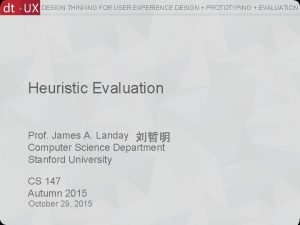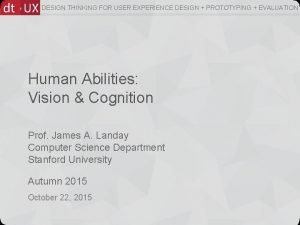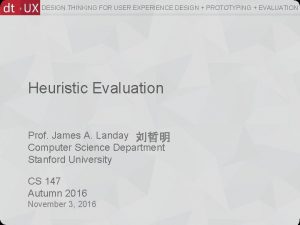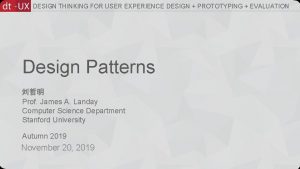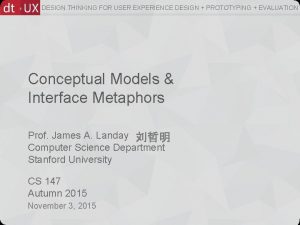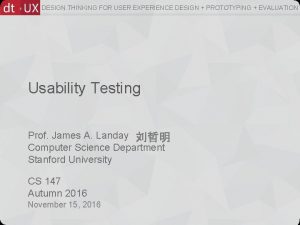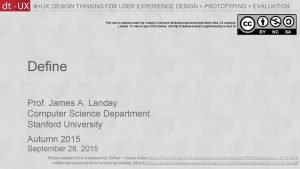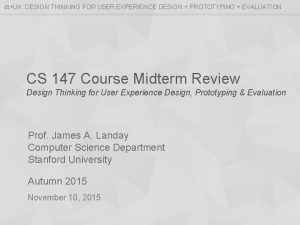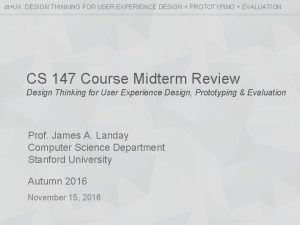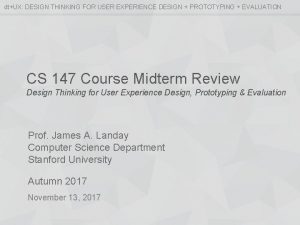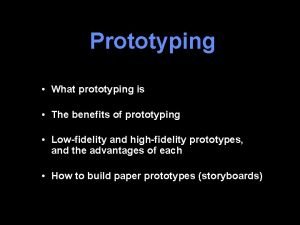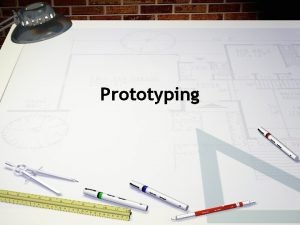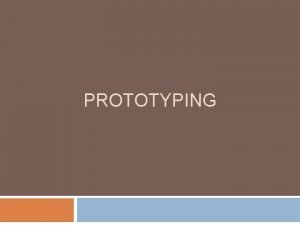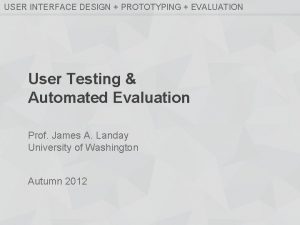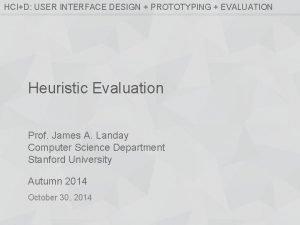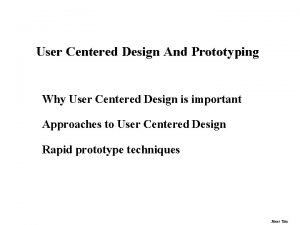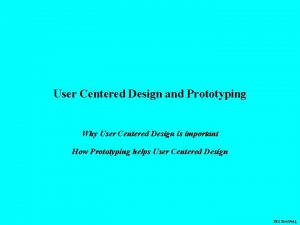DESIGN THINKING FOR USER EXPERIENCE DESIGN PROTOTYPING EVALUATION



























































- Slides: 59

DESIGN THINKING FOR USER EXPERIENCE DESIGN + PROTOTYPING + EVALUATION Human Abilities: Vision & Cognition 刘哲明 Prof. James A. Landay Computer Science Department Stanford University Autumn 2019 November 6, 2019

Hall of Fame or Shame? 2019/11/05 dt+UX: Design Thinking for User Experience Design, Prototyping & Evaluation 2

Hall of Fame or Shame? 2019/11/05 dt+UX: Design Thinking for User Experience Design, Prototyping & Evaluation 3

Hall of Fame! Clearly highlights error (red text & box) Tells me what I did wrong/how to fix it In user’s language (but, be careful w/ humor) Red may be an issue when used alone, more later. . . 2019/11/05 dt+UX: Design Thinking for User Experience Design, Prototyping & Evaluation 4

Hall of Fame! Clearly highlights error (red text & box) Tells me what I did wrong/how to fix it In user’s language (but, be careful w/ humor) Red may be an issue when used alone, more later. . . 2019/11/05 New version fixes these last 2 problems dt+UX: Design Thinking for User Experience Design, Prototyping & Evaluation 5

Hall of Fame or Shame? 2019/11/05 dt+UX: Design Thinking for User Experience Design, Prototyping & Evaluation 6

Hall of Shame! Error Messages – where is the error? – what’s wrong with it? – parse & fix it yourself! 2019/11/05 dt+UX: Design Thinking for User Experience Design, Prototyping & Evaluation 7

DESIGN THINKING FOR USER EXPERIENCE DESIGN + PROTOTYPING + EVALUATION Human Abilities: Vision & Cognition 刘哲明 Prof. James A. Landay Computer Science Department Stanford University Autumn 2019 November 6, 2019

Outline • • • 2019/11/05 Human visual system Guidelines for design Team Break Models of human performance (MHP) Two in class experiments Memory dt+UX: Design Thinking for User Experience Design, Prototyping & Evaluation 9

Why Study Color? 2019/11/05 1) Color can be a powerful tool to improve user interfaces by communicating key information 2) Inappropriate use of color can severely reduce the performance of systems we build dt+UX: Design Thinking for User Experience Design, Prototyping & Evaluation 10

Visible Spectrum UV IR Wavelength (nm) 2019/11/05 dt+UX: Design Thinking for User Experience Design, Prototyping & Evaluation 11

Human Visual System • Light passes through lens • Focused on retina http: //obsessive-coffee-disorder. com/wp-content/uploads/2014/11/eye 1. jpg 2019/11/05 dt+UX: Design Thinking for User Experience Design, Prototyping & Evaluation 12

Retina • Retina covered with two types of light-sensitive receptors called? – rods • • – cones • 2019/11/05 primarily for night vision & perceiving movement sensitive to broad spectrum of light can’t discriminate between colors sense intensity or shades of gray used to sense color dt+UX: Design Thinking for User Experience Design, Prototyping & Evaluation http: //www. webexhibits. org/causesofcolor/1 G. html 13

Retina • Center of retina has most of the cones – allows for high acuity of objects focused at center http: //www. webexhibits. org/causesofcolor/1 G. html • Edge of retina is dominated by rods – 2019/11/05 http: //webvision. med. utah. edu/imageswv/Ostergr. jpeg allows detecting motion of threats in periphery dt+UX: Design Thinking for User Experience Design, Prototyping & Evaluation 14

Color Perception via Cones • • “Photopigments” used to sense color 3 types: blue, green, “red” (really yellow) each sensitive to different band of spectrum – ratio of neural activity of the 3 color – • other colors are perceived by combining stimulation http: //www. webexhibits. org/causesofcolor/1 G. html 2019/11/05 dt+UX: Design Thinking for User Experience Design, Prototyping & Evaluation 15

Color Sensitivity AKA Red lots of overlap not as sensitive to blue http: //archive. cnx. org/contents/d 42 c 807 d-a 9 fa-4 e 3 d-83 d 0 -0 f 7 c 745 b 51 a 0@4/color-and-color-vision#import-auto-id 1844887 2019/11/05 dt+UX: Design Thinking for User Experience Design, Prototyping & Evaluation 16

Color Sensitivity Centered on yellow http: //retina. umh. es/webvision/imageswv/spectra. jpeg 2019/11/05 dt+UX: Design Thinking for User Experience Design, Prototyping & Evaluation 17

Distribution of Photopigments • Not distributed evenly – mainly reds (64%) & very few blues (4%) – • insensitivity to short wavelengths (blue) Few blue cones in retina center (high acuity) – “disappearance” of small blue objects you fixate on http: //www. webexhibits. org/causesofcolor/1 G. html • As we age lens yellows & absorbs shorter wavelengths – • Implication – 2019/11/05 sensitivity to blue is even more reduced don’t rely on blue for text or small objects! dt+UX: Design Thinking for User Experience Design, Prototyping & Evaluation 18

Focus • Different wavelengths of light focused at different distances behind eye’s lens – need for constant refocusing ? • – 2019/11/05 causes fatigue be careful about color combinations dt+UX: Design Thinking for User Experience Design, Prototyping & Evaluation 19

Focus • Different wavelengths of light focused at different distances behind eye’s lens – need for constant refocusing ? • – • causes fatigue be careful about color combinations Pure (saturated) colors require more focusing than less pure (desaturated) – don’t use saturated colors in UIs unless you really need something to stand out http: //www. pallasweb. com/color. html 2019/11/05 dt+UX: Design Thinking for User Experience Design, Prototyping & Evaluation 20

Color Deficiency (Also known as “color blindness”) • Trouble discriminating colors – • besets about 4. 5% of population (~8% men, ~. 5% women) Two main types – different photopigment response most common • – red-green deficiency is best known • 2019/11/05 reduces capability to discern small color diffs lack of either green or red photopigment can’t discriminate colors solely dependent on Red & Green dt+UX: Design Thinking for User Experience Design, Prototyping & Evaluation Difficult pairs for severe red deficient person to discern https: //www. color-blindness. com/red-green-color-blindness/ 21

Color Guidelines Avoid simultaneous display of highly saturated, spectrally extreme colors – e. g. , no cyans/blues at the same time as reds, why? • – 2019/11/05 refocusing! desaturated combinations are better pastels dt+UX: Design Thinking for User Experience Design, Prototyping & Evaluation 22

Use the Hue Circle Pick non-adjacent colors – opponent colors go well together red & green or yellow & blue 2019/11/05 dt+UX: Design Thinking for User Experience Design, Prototyping & Evaluation 23

Color Guidelines (cont. ) • Avoid pure blue for text, lines & small shapes • Avoid adjacent colors that differ only in blue • Blue makes a great background color TO BLUE 2019/11/05 dt+UX: Design Thinking for User Experience Design, Prototyping & Evaluation 24

Color Guidelines (cont. ) • Size of detectable changes in color varies – – – • Hard to focus on edges created by only color – • use both brightness & color differences Avoid single-color distinctions – – 2019/11/05 hard to detect changes in reds, purples, & greens easier to detect changes in yellows & blue-greens older users need higher brightness levels mixtures of colors should differ in 2 or 3 colors helps color-deficient observers dt+UX: Design Thinking for User Experience Design, Prototyping & Evaluation 25

Administrivia • 2019/11/05 React Native workshop for Monday, Nov. 11 th, 5 -7 pm, location TBD dt+UX: Design Thinking for User Experience Design, Prototyping & Evaluation 26

Administrivia 2019/11/05 dt+UX: Design Thinking for User Experience Design, Prototyping & Evaluation 27

Administrivia 2019/11/05 dt+UX: Design Thinking for User Experience Design, Prototyping & Evaluation 28

TEAM BREAK 2019/11/05 dt+UX: Design Thinking for User Experience Design, Prototyping & Evaluation 29

The Model Human Processor Developed by Card, Moran & Newell (’ 83) – 2019/11/05 based on empirical data dt+UX: Design Thinking for User Experience Design, Prototyping & Evaluation 30

The Model Human Processor Long-term Memory Working Memory sensory buffers Eyes Ears Visual Image Store Perceptual Processor Auditory Image Store Motor Processor Cognitive Processor Fingers, etc. 2019/11/05 dt+UX: Design Thinking for User Experience Design, Prototyping & Evaluation 31

MHP Basics • Sometimes serial, sometimes parallel – serial in action & parallel in recognition • • • pressing key in response to light (serial) driving, reading signs & hearing at once (parallel) Parameters processors have cycle time (T) ~ 100 ms – memories have capacity, decay time & type – 2019/11/05 dt+UX: Design Thinking for User Experience Design, Prototyping & Evaluation 32

What is missing from MHP? Long-term Memory Working Memory sensory buffers Eyes Ears Visual Image Store Perceptual Processor Auditory Image Store Motor Processor Cognitive Processor Fingers, etc. 2019/11/05 dt+UX: Design Thinking for User Experience Design, Prototyping & Evaluation 33

What is missing from MHP? • Haptic memory – • Moving from sensory memory to WM – • attention filters stimuli & passes to WM Moving from WM to LTM – 2019/11/05 for touch elaboration dt+UX: Design Thinking for User Experience Design, Prototyping & Evaluation 34

2019/11/05 dt+UX: Design Thinking for User Experience Design, Prototyping & Evaluation 35

Memory • Working memory (short term) – small capacity (7 ± 2 “chunks”) • • – rapid access (~70 ms) & decay (~200 ms) • • 6174591765 vs. (617) 459 -1765 NBCIBMGMC vs. NBC IBM GMC pass to LTM after a few seconds of continued storage Long-term memory huge (if not “unlimited”) – slower access time (~100 ms) w/ little decay – 2019/11/05 dt+UX: Design Thinking for User Experience Design, Prototyping & Evaluation 36

MHP Principles of Operation • Recognize-Act Cycle of the CP on each cycle contents in WM initiate actions associatively linked to them in LTM – actions modify the contents of WM – 2019/11/05 dt+UX: Design Thinking for User Experience Design, Prototyping & Evaluation 37

MHP Principles of Operation Long-term Memory Working Memory sensory buffers Eyes Ears Visual Image Store Perceptual Processor Auditory Image Store Motor Processor Cognitive Processor Fingers, etc. 2019/11/05 dt+UX: Design Thinking for User Experience Design, Prototyping & Evaluation 38

MHP Principles of Operation • Recognize-Act Cycle of the CP on each cycle contents in WM initiate actions associatively linked to them in LTM – actions modify the contents of WM – • Discrimination Principle retrieval is determined by candidates that exist in memory relative to retrieval cues – interference by strongly activated chunks – 2019/11/05 dt+UX: Design Thinking for User Experience Design, Prototyping & Evaluation 39

Experiment • Task: Quickly tap each target 50 times accurately • Conditions: – – • 2019/11/05 Two ½” diameter targets 6” apart Two ½” diameter targets 24” apart Two 2” diameter targets 24” apart (no accuracy required) Turn to neighbor: discuss what will happen dt+UX: Design Thinking for User Experience Design, Prototyping & Evaluation 40

Experimental Results • Task: Quickly tap each target 50 times accurately 2019/11/05 dt+UX: Design Thinking for User Experience Design, Prototyping & Evaluation 41

Experimental Results (last year) • Task: Quickly tap each target 50 times accurately 2019/11/05 dt+UX: Design Thinking for User Experience Design, Prototyping & Evaluation 42

Experimental Results (2 years ago) • Task: Quickly tap each target 50 times accurately 30 sec 48 sec 31 sec 21 sec (lots of spread) 2019/11/05 dt+UX: Design Thinking for User Experience Design, Prototyping & Evaluation 43

Experimental Results (3 years ago) • Task: Quickly tap each target 50 times accurately 2019/11/05 dt+UX: Design Thinking for User Experience Design, Prototyping & Evaluation 44

Principles of Operation (cont. ) Fitts’ Law – moving hand is a series of microcorrections • – correction takes Tp + Tc + Tm = 240 msec time Tpos to move the hand to target size S, which is distance D away is given by: Tpos = a + b log 2 (D/S + 1) – summary • 2019/11/05 time to move the hand depends only on the relative precision required dt+UX: Design Thinking for User Experience Design, Prototyping & Evaluation 45

Fitts’ Law Example Pop-up Linear Menu Pop-up Pie Menu Today Sunday Monday Tuesday Wednesday Thursday Friday Saturday Which will be faster on average? – 2019/11/05 pie menu (bigger targets & less distance) dt+UX: Design Thinking for User Experience Design, Prototyping & Evaluation 46

Pie Menus in Use Today Rainbow 6 The Sims Firefox 2019/11/05 Maya dt+UX: Design Thinking for User Experience Design, Prototyping & Evaluation 47

Apple Watch Is a Negative Fitts’ Law Example 2019/11/05 dt+UX: Design Thinking for User Experience Design, Prototyping & Evaluation 48

Simple Experiment • • Volunteer Start saying colors you see in list of words when slide comes up – as fast as you can – • • 2019/11/05 Say “done” when finished Everyone else time it… dt+UX: Design Thinking for User Experience Design, Prototyping & Evaluation 49

Paper Home Back Schedule Page Change 2019/11/05 dt+UX: Design Thinking for User Experience Design, Prototyping & Evaluation 50

Simple Experiment • • 2019/11/05 Do it again Say “done” when finished dt+UX: Design Thinking for User Experience Design, Prototyping & Evaluation 51

Bandana Forward Home Test Basket Paper 2019/11/05 dt+UX: Design Thinking for User Experience Design, Prototyping & Evaluation 52

Simple Experiment • • 2019/11/05 Do it again Say “done” when finished dt+UX: Design Thinking for User Experience Design, Prototyping & Evaluation 53

Yellow White Black Blue Red Green 2019/11/05 dt+UX: Design Thinking for User Experience Design, Prototyping & Evaluation 54

Memory • Interference two strong cues in working memory – link to different chunks in long term memory – • Why learn about memory? know what’s behind many HCI techniques – helps you understand what users will “get” – aging population of users – 2019/11/05 dt+UX: Design Thinking for User Experience Design, Prototyping & Evaluation 55

Design UIs for Recognition over Recall • Recall – – • info reproduced from memory e. g. , command name & semantics Recognition – presentation of info provides knowledge that info has been seen before • – easier because of cues to retrieval • • 2019/11/05 e. g. , command in menu reminds you cue is related to item or situation learned in e. g. , hints, icons, labels, menu names, etc. dt+UX: Design Thinking for User Experience Design, Prototyping & Evaluation 56

Human Abilities Summary • Color can be helpful, but pay attention to – – – • Model Human Processor – – • – – 2019/11/05 perceptual, motor, cognitive processors + memory model allows us to make predictions Memory – • how colors combine limitations of human perception people with color deficiency three types: sensory, WM & LTM interference can make hard to access LTM cues in WM can make it easier to access LTM Key time to remember from MHP: ~100 ms cycle time & memory access time dt+UX: Design Thinking for User Experience Design, Prototyping & Evaluation 57

Further Reading Vision and Cognition • Books – – – 2019/11/05 The Psychology Of Human-Computer Interaction, by Card, Moran, & Newell, Erlbaum, 1983 Human-Computer Interaction, by Dix, Finlay, Abowd, and Beale, 1998. Perception, Irvin Rock, 1995. • Pages 66 -99 of “Cognitive Aspects in Interaction Design”, from Interaction Design, 3 rd Edition by Rogers, Sharp, & Preece • Applying Fitts’ Law to Mobile Interface Design by Justin Smith dt+UX: Design Thinking for User Experience Design, Prototyping & Evaluation 58

Next Time • Conceptual Models & Interface Metaphors – • Read “The Psychology of Everyday Things” (Ch. 1), from The Design of Everyday Things by Donald Norman Studio Ad-hoc group heuristic evaluation – Must be present to get credit on assignment – 2019/11/05 dt+UX: Design Thinking for User Experience Design, Prototyping & Evaluation 59
 User interface prototyping in software engineering
User interface prototyping in software engineering User interface design and evaluation
User interface design and evaluation Imprinting meaning psychology
Imprinting meaning psychology Early experience vs later experience
Early experience vs later experience Indirect experience
Indirect experience User experience model
User experience model Design right
Design right User experience
User experience Semantisches differential auswertung
Semantisches differential auswertung Augmented reality user experience
Augmented reality user experience Single user and multiple user operating system
Single user and multiple user operating system Multi user operating system
Multi user operating system Design prototyping and construction
Design prototyping and construction Query techniques in hci
Query techniques in hci Gulf of execution and evaluation
Gulf of execution and evaluation Positive thinking vs negative thinking examples
Positive thinking vs negative thinking examples Thinking about your own thinking
Thinking about your own thinking Holistic judgement
Holistic judgement Perbedaan critical thinking dan creative thinking
Perbedaan critical thinking dan creative thinking Thinking about you thinking about me
Thinking about you thinking about me User interface design in system analysis and design
User interface design in system analysis and design Design of output
Design of output Iso 22301 utbildning
Iso 22301 utbildning Typiska drag för en novell
Typiska drag för en novell Tack för att ni lyssnade bild
Tack för att ni lyssnade bild Vad står k.r.å.k.a.n för
Vad står k.r.å.k.a.n för Varför kallas perioden 1918-1939 för mellankrigstiden?
Varför kallas perioden 1918-1939 för mellankrigstiden? En lathund för arbete med kontinuitetshantering
En lathund för arbete med kontinuitetshantering Särskild löneskatt för pensionskostnader
Särskild löneskatt för pensionskostnader Tidbok för yrkesförare
Tidbok för yrkesförare Anatomi organ reproduksi
Anatomi organ reproduksi Förklara densitet för barn
Förklara densitet för barn Datorkunskap för nybörjare
Datorkunskap för nybörjare Boverket ka
Boverket ka Mall för debattartikel
Mall för debattartikel För och nackdelar med firo
För och nackdelar med firo Nyckelkompetenser för livslångt lärande
Nyckelkompetenser för livslångt lärande Påbyggnader för flakfordon
Påbyggnader för flakfordon Arkimedes princip formel
Arkimedes princip formel Offentlig förvaltning
Offentlig förvaltning Kyssande vind analys
Kyssande vind analys Presentera för publik crossboss
Presentera för publik crossboss Teckenspråk minoritetsspråk argument
Teckenspråk minoritetsspråk argument Plats för toran ark
Plats för toran ark Klassificeringsstruktur för kommunala verksamheter
Klassificeringsstruktur för kommunala verksamheter Fimbrietratt
Fimbrietratt Claes martinsson
Claes martinsson Cks
Cks Lågenergihus nyproduktion
Lågenergihus nyproduktion Mat för idrottare
Mat för idrottare Verktyg för automatisering av utbetalningar
Verktyg för automatisering av utbetalningar Rutin för avvikelsehantering
Rutin för avvikelsehantering Smärtskolan kunskap för livet
Smärtskolan kunskap för livet Ministerstyre för och nackdelar
Ministerstyre för och nackdelar Tack för att ni har lyssnat
Tack för att ni har lyssnat Referatmarkeringar
Referatmarkeringar Redogör för vad psykologi är
Redogör för vad psykologi är Matematisk modellering eksempel
Matematisk modellering eksempel Tack för att ni har lyssnat
Tack för att ni har lyssnat Borra hål för knoppar
Borra hål för knoppar
